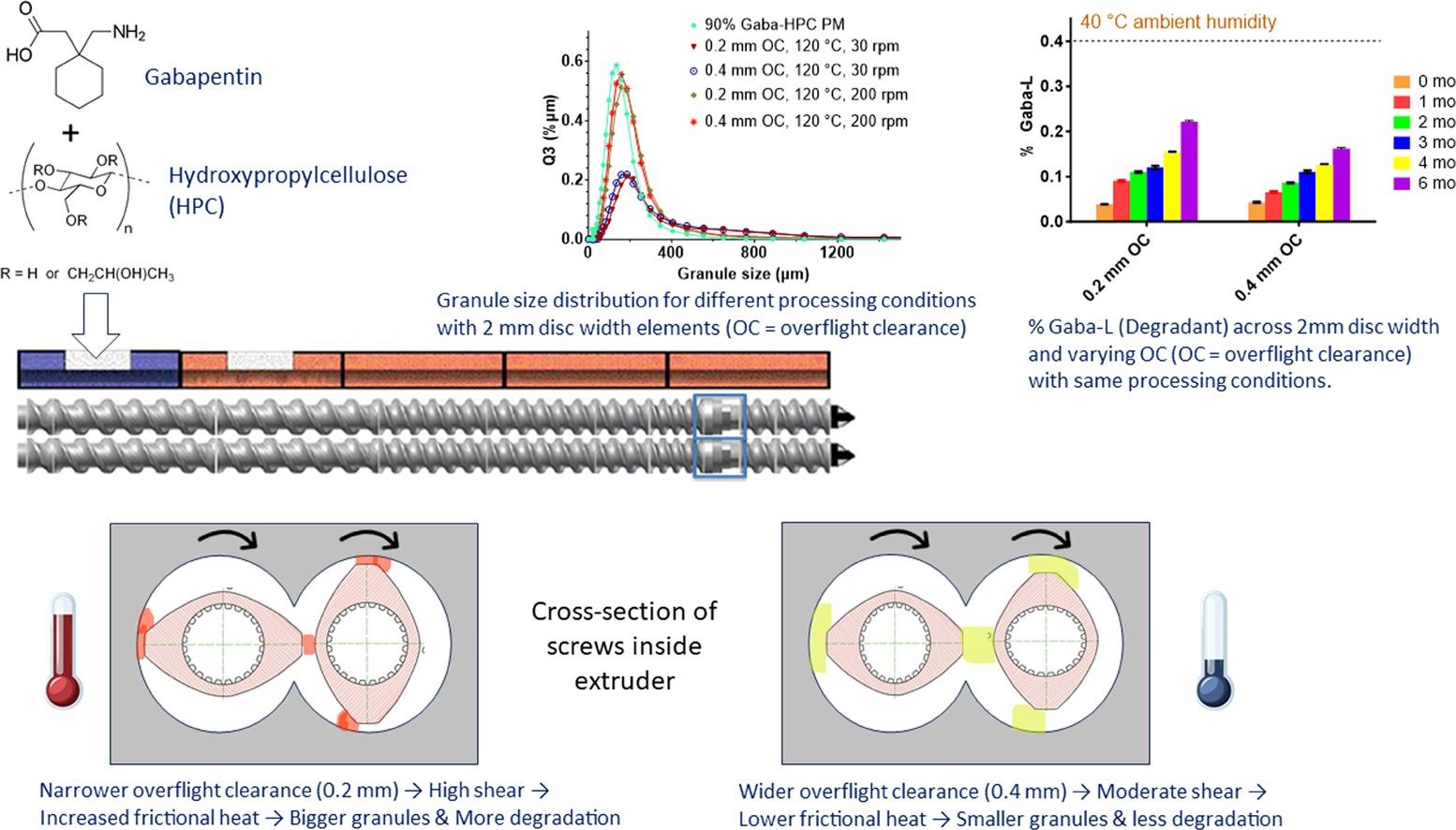Optimizing twin-screw melt granulation: The role of overflight clearance on granulation behavior

Abstract
Twin-screw melt granulation (TSMG) relies on the dispersive and distributive mixing at the kneading zone for granule growth to happen highlighting the critical role played by the kneading elements in TSMG. Despite extensive research conducted on the impact of screw geometry in melt compounding, there is not enough literature for TSMG. Disc width for the kneading elements was 2 mm, contrary to the standard 5 mm. The objective of this study was to evaluate if varying overflight clearance (OC) can alter the paradigm for TSMG. The new elements reduce the peak shear at kneading zone however a higher barrel temperature and degree of fill (DoF) is required to compensate to attain similar granule attributes. The change in DoF was achieved through a combination of modified screw configuration to pre-densify powders before kneading and processing at a lower screw speed. Despite the higher barrel temperature, process optimization of thermally unstable gabapentin was carried out. Using the new elements, compressible granules (Tensile strength > 2 MPa) with low % GABA-L content were manufactured despite increasing OC to 0.4 mm. Granule stability at 40 °C, ambient humidity for 6 months indicated gabapentin was stable (% GABA-L ≪0.4 %) despite a high barrel temperature of 120 °C.
Highlights
- New kneading elements were developed with reduced width and increased clearance.
- New kneading elements reduce peak shear & dispersive mixing at kneading zone.
- Higher barrel temperature & degree of fill is needed to compensate for lost shear.
- Stable granules were formulated for thermolabile gabapentin by a thermal process.
Introduction
Twin-screw processing has been around in the plastics and food industry for a few decades now mainly through twin-screw extrusions (TSE) and more recently granulation with applications across different industries from production of lithium batteries to pharmaceuticals (Martin, 2016). Ever since Rezulin™, the first TSE product for the solubility enhancement of troglitazone (Ghebre-Sellassie, 2001), twin-screw processing gained popularity in development of amorphous solid dispersions (Lang et al., 2014), films, granulation (both wet and melt) (Kittikunakorn et al., 2020), long-acting implants (Costello et al., 2023) and more recently co-processing excipients (Pradhan et al., 2022) and continuous powder blending (Ren et al., 2023). Twin-screw melt granulation (TSMG) utilizes a thermoplastic polymer as the binder to densify poorly compactable drugs using a twin-screw extruder. The bridges between the two particles during granule growth are formed by the molten binder making it alike wet granulation as it follows the nucleation, growth, and consolidation phase (Liu et al., 2021).
Kittikunakorn et al. studied the effect of thermal binders on drug stability and observed a positive correlation with gabapentin degradation and melt viscosity of binder due to a higher melt viscosity translating to increased shear at the kneading zone and formation of hot spots (Kittikunakorn et al., 2019a). This makes the choice of a binder and binder level absolutely critical in a TSMG process. In addition to the formulation variables, different screw configuration and processing conditions also impact the drug stability and granulation process significantly (Kittikunakorn et al., 2021, Lakshman et al., 2011, Liu et al., 2022, Liu and Zhang, 2023). The excessive shear during TSMG may lead to over-granulation and local melting leading to degradation (Forster et al., 2021). This local melting can be attributed to the aggressive shear at the kneading elements and the impact of screw geometry especially overflight clearance and disc width on drug stability has not been investigated sufficiently.
A twin-screw extruder comprises of a set of screws mounted on two shafts (co-rotating or counter-rotating) subjected to an elevated temperature for thermomechanical processing (Martin, 2016). The screw elements primarily consist of the conveying elements and the mixing (kneading) elements. Conveying elements are responsible for material transport while the kneading elements are responsible for the dispersive and distributive mixing which imparts shear during processing (Kittikunakorn et al., 2020). Andersen et al. investigated how the mixing performance of the kneading block is related to the no. of lobes, disc width (DW), staggering angle, absolute pressure and melt viscosity etc. (Andersen, 2018). Wider DW kneading elements impart more extensional and planar shear leading to more aggressive mixing due to the axial forces on the material from both upstream and downstream (Martin, 2016, Todd, 1998). Reducing DW reduces the dispersive shear while also allowing the material to be conveyed easily facilitating distributive mixing (Liu et al., 2021). The reduced dispersive shear and improved distributive mixing makes the narrow DW kneading elements a good choice for processing shear and thermally labile drug products.
Martin et al. shed light on the shear intensity across different regions of the cross-section of a twin-screw extruder in his review (Fig. 1). The gap between the screw tip and barrel wall is defined as the overflight clearance (OC) (Kittikunakorn et al., 2020). The narrow overflight clearance and the gap between two intermeshing screws are two of the most shear intensive regions inside the extruder resulting in a non-uniform shear profile at the kneading zone (Martin, 2016) (Fig. 1). Todd et al. observed an inverse relation of the overflight clearance to the peak shear rate as described by Equation (1) (Todd, 1998). Ishikawa et al. and Donoian et al. investigated the effect of changing overflight clearance on mixing performance in TSE and concluded that widening the overflight clearance reduced the energy input and viscous dissipation making the temperature profile more gentle and shear profile more uniform (Donoian, 1999, Ishikawa et al., 2006). Equation (1). Formula for peak shear rate where D = Diameter of extruder (mm), n = Screw speed (rpm), ƞ = Viscosity at barrel temperature, h = Overflight clearance (mm).
However, the impact of overflight clearance on the TSMG process and drug stability has not been investigated at all despite being one of the most shear-intensive regions. Hence, the main focus of our research was to elucidate the impact of varying OC on the drug degradation and granule densification process. The untapped potential of the wider OC and narrow DW kneading elements in TSMG formed the foundation for Leistritz Extrusion Technology to manufacture these new screw designs (Figure S1). Table 1 compares the DW and OC for the standard and new kneading elements for the Leistritz ZSE-18 extruder.
The peak shear at the overflight region produces local heat at the kneading zone inducing in-process physicochemical changes not limited to drug degradation, amorphization, polymorphism (Kittikunakorn et al., 2020). This has been a defining bottleneck restricting the wide-spread adoption of TSMG. Gabapentin (GABA) was selected as the model drug due to its thermal and shear-sensitive properties for elucidating drug stability. Gabapentin is a crystalline high dose drug with poor compressibility and commercially manufactured using a wet granulation process (Neurontin ®) (Kittikunakorn et al., 2019a). GABA is thermally unstable as it degrades rapidly to gabalactam (GABA-L) upon melting via an intramolecular cyclization reaction (Zong et al., 2012). USP limits gabalactam NMT 0.1 % for pure drug and NMT 0.4 % for final drug products due to the potential toxicity associated with the 30-fold lower LD50 value of GABA-L compared to GABA (Pharmacopoeia, xxxx, Zambon et al., 2008). Zong et al. investigated the effect of shear and observed higher GABA degradation with increased milling time (Zong et al., 2012). Thus, making gabapentin an excellent model for our study. Hydroxypropylcellulose (HPC) was chosen as the thermoplastic binder for TSMG due to its superior ability in improving the compaction properties of poorly compressible drugs (Batra et al., 2017, Pradhan et al., 2022). The formulation was kept constant as the main focus was on the impact of processing especially screw overflight clearance on TSMG. HPC (binder) level was fixed at 10 % based on the chemical stability of gabapentin and the minimum binder level required for a robust TSMG of an immiscible drug-polymer blend (Pradhan et al., 2022).
Process optimization was very critical to elucidate the impact of increasing OC on granule attributes and drug stability. This was achieved using the 4 key processing variables namely: Barrel temperature (°C), screw speed (rpm), overflight clearance (mm), feed rate (kg/h) all at 2 levels. Since the intricate interplay between residence time, barrel temperature and degree of fill govern the granule attributes, a full factorial design was employed for process optimization to capture the main and interaction effects of all processing variables. % GABA-L (Degradant) was chosen as the main response variable. As the increased OC and narrow DW reduces dispersive mixing, granule densification is impacted. Thus, tablet tensile strength was chosen as a response variable. Granulation runs with standard kneading elements and conveying elements were conducted as reference points to elucidate the impact of varying overflight clearance.
System parameters like residence time, degree of fill, specific feed rate, specific mechanical energy (SME) have correlated strongly to granule properties highlighting the importance of a detailed understanding of their correlation with drug degradation and granule attributes (Kittikunakorn et al., 2020). Thus, a linear regression analysis was conducted to evaluate the correlation. In addition to system parameters, Van de Steene et al. observed a good correlation between granule temperature and granule quality attributes while Kittikunakorn et al. observed a strong positive correlation between granule temperature and drug degradation (Kittikunakorn et al., 2021, Van de Steene et al., 2023). Thus, granule temperature at discharge was measured as an indicator of local heat generation apart from elucidating granulation mechanisms.
Read more here
Materials
Crystalline gabapentin (GABA) available in polymorphic form II was used as a model drug in this study. It was purchased from Shenzhen Nexconn Pharmatechs Ltd. (Shenzhen, China). Crystalline mannitol (Pearlitol® 50C), used for preliminary prototype runs was received as a gift sample from Roquette America Inc. (Geneva, IL, USA). Fine particle size grade of hydroxypropylcellulose (Klucel® EXF) was donated by Ashland Specialty Ingredients Inc. (Wilmington, DE).
Adwait Pradhan, Brian Phillips, Fengyuan Yang, Kapish Karan, Thomas Durig, Brian Haight, Charlie Martin, Feng Zhang, Optimizing twin-screw melt granulation: The role of overflight clearance on granulation behavior, International Journal of Pharmaceutics, Volume 653, 2024, 123900, ISSN 0378-5173, https://doi.org/10.1016/j.ijpharm.2024.123900.
Read also our introduction article on Mannitol here:


